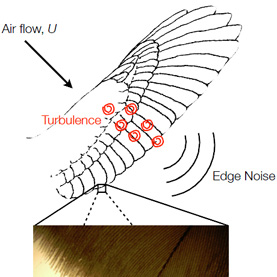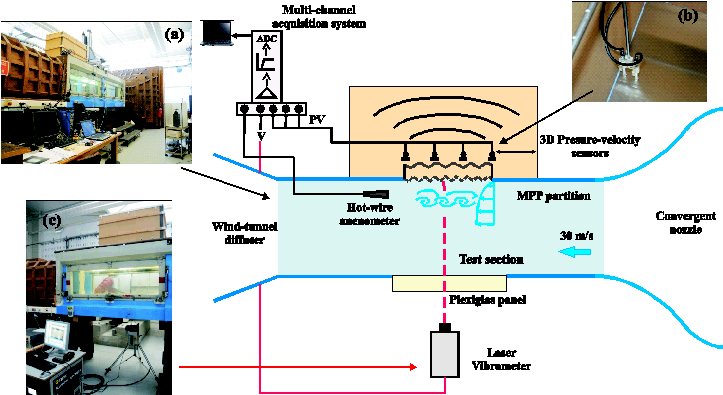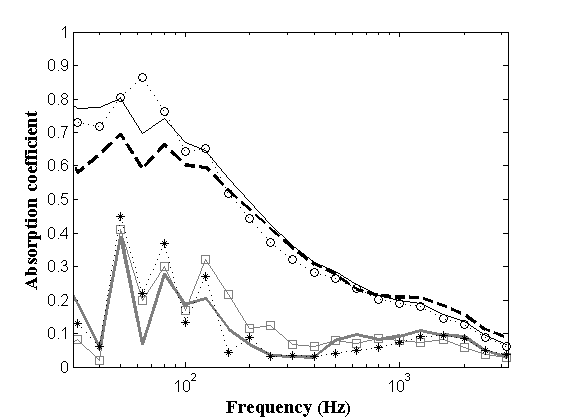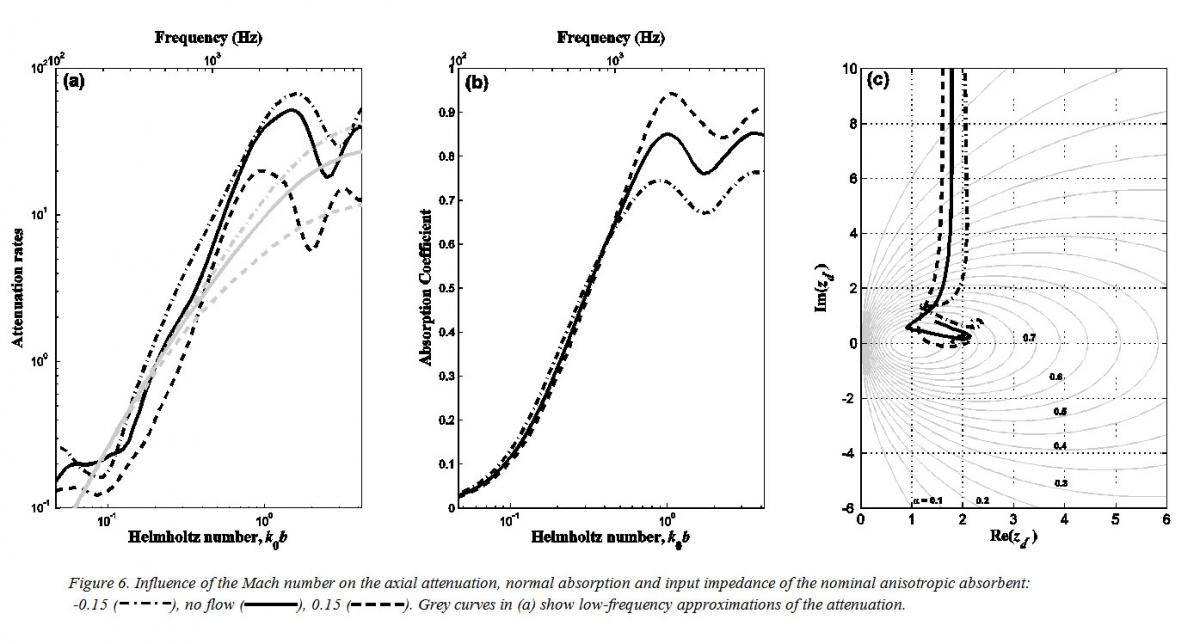As a consequence of the continuous air transport growth and to comply with stringent environmental regulations, there is a strong demand for the development of novel noise reduction techniques in the aeronautical sector at an acceptable cost and weight. The general objective of this project is to design innovative surface treatments that would be applied on portions of aircraft fuselage and wings in order to reduce the exposure of the community to airborne and airframe noise sources. For this, we have been inspired by the silent flight of certain nocturnal predatory birds, such as owls, which are able to fly close to their prey without being detected above 1.6 kHz due to the special morphology of their wing plumages, schematically shown in Fig. 1.


Figure 1. (Left) Generation and attenuation of the turbulence eddies by the owls wing (from http://www.damtp.cam.ac.uk/user/waves/research.html); Schematic arrangement of the outer (A) and inner (B) vanes of the owl wing's velvety down feathers (from Bachmann et al., 2007).
In this work we have shown that sole combinations of locally-reacting absorbent materials are not able of reproducing the owls' wings hush-kit, organized in layers of non locally-reacting fibers whose inclination is Mach-number dependent, in very much the same way as trees in a forest canopy. It was then necessary to characterize and model new types of materials, including thin micro-perforated panels or membranes, shielding and intermixed with anisotropic fibrous materials, all combined in a multilayer partition, as shown in Fig. 2

The study started with a theoretical and experimental characterization of microperforated anisotropic absorbers. Although microperforates have been characterized in numerous works, most of the studies carried out involved applications in room acoustics, that considers resonant absorbers located on the walls and ceiling of enclosures. For aeronautical applications, it is essential to consider both a turbulent boundary layer (TBL) excitation as well as coupling of the micro-perforate with a mean grazing flow of air, which has not been considered to the authors knowledge. In the BIOWING project, a fully coupled analytical model has been developed based on a modal decomposition of the pressure and acoustic velocity for the prediction of the absorption coefficient and the transmission loss of microperforated partitions undergoing plane wave or random excitations such as a TBL. The predictions have been validated against a series of measurements. Specifically, in-situ normal incidence absorption measurements have been carried out in the no-flow case in an anechoic chamber using a miniature pressure-velocity probe over a several anisotropic materials (fiberglass, goose down, sisal) whose fiber diameters ranged from 7 to 100 µm. It is illustrated in Fig. 3 for sisal fibers for which the non-locally reacting fully anisotropic model appears to be well correlated with in-duct and pressure-velocity absorption measurements up to 1 kHz, unlike semi-empirical models for locally-reacting materials.

The absorption and insulation performance of micro-perforated partitions have also been measured in a wind tunnel under a fully-developed TBL with a mean flow velocity of 30.7 m.s-1 using an innovative experimental methodology summarized in Fig. 4. This led to an estimate of the frequency-averaged power flow injected by an aeroacoustic excitation into the partition.

Figure 4. (a) Overall view of the IRPHE low-speed wind-tunnel facility equipped to measure the Transmission Loss and absorption coefficient of micro-perforated partitions flush-mounted over the top wall of the test section and excited by a turbulent boundary layer; (b) Close view of two pressure-velocity sensors located in the near-field of the back panel radiating into the transmitting enclosure; (c) Scanning laser vibrometer used to measure the normal velocity of the front MPP by transparency through the bottom wall of the test section.
As shown in Fig. 5, a hole-based transitional Strouhal number (dimensionless frequency) was found below which low-back scattering of the aerodynamic wall-pressures occurred and above which the microperforations efficiently convert turbulence into back-scattered sound whatever the magnitude of the acoustic component. Of interest is that a minute increase of the acoustic component generates most of the transmission loss decrease.

Figure 5. Measured third-octave averaged absorption curves for a number of partitions undergoing a TBL excitation (30.7 m.s-1): Panel-Cavity-Panel (thick grey: calculated; squares: measured), MPP-Cavity-Panel (dashed black: calculation from the full injected power; thin black: calculation when neglecting the contribution of the cavity pressure to the injected power; stars: evaluated from sole laser vibrometer measurements; circles: evaluated from both laser vibrometer and wall-pressure measurements).
In order to reproduce the internal structure of the owl wings velvety down, composed of a series of rigid fibers directed almost perpendicular to the surface, but that tend to bend under mean flow effects, a completely new study of fibrous materials has been carried out. It has been shown that the existing model so far, the "Multiple Scattering Theory" is not sufficient for a correct prediction of the acoustic characteristics of a fibrous layer with transverse orientations of fibers coupled to an external flow. A model assuming a uniform flow and wave propagation into an anisotropic fibrous materials shielded by a microperforate has been developed. It led to a flow-structure transcendental equation, efficiently solved in the complex wavenumber domain by the "simulated annealing" algorithm. It allowed to assess the influence of several parameters constitutive of the anisotropic material, of the micro-perforate or of the external flow on the absorption coefficient, and most importantly on the axial attenuation rate, as shown in Fig. 6. In particular, it was found that upstream propagation conditions lead to an increase of the axial attenuation, especially for vertical fibres orientation, whereas it decreases under downstream propagation conditions. This excess or deficit of axial attenuation with respect to the no-flow case is much more pronounced when the material thickness is larger than the acoustic wavelength. The Mach-number dependence is reversed when dealing with the absorption coefficient that decreases for upstream propagation and increases for downstream propagation, especially for horizontal fibres orientation.

The modeling and experimental methodologies developed through the BIOWING project have been applied to two specific configurations of great interest in the transportation industry: the use of micro-perforated partitions to reduce noise emissions in ventilation systems, exhaust pipes and air conditioning systems, and the control of the tonal noise generated by a TBL over the aircraft fuselage. In both cases it has been demonstrated that, if suitably optimised, the proposed micro-perforated fibrous partitions constitute a viable soundproof solution in terms of cost and weight that a priori should not degrade the functional stability nor the safety conditions of the airplane.
Publicaciones
| Optimisation of micro-perforated cylindrical silencers in linear and nonlinear regimesT. Bravo, C. Maury and C. PinhèdeJournal of Sound and Vibration, vol. 363, 2016, pp. 359-379https://doi.org/10.1016/j.jsv.2015.11.011 | GAA |
| Sound attenuation and absorption by anisotropic fibrous materials: Theoretical and experimental studyTeresa Bravo, Cédric Maurytheoretical and experimental study, Journal of Sound and Vibration 417, 165-181https://doi.org/10.1016/j.jsv.2017.11.037 | GAA |
| Sound attenuation and absorption by microperforated panels backed by anisotropic fibrous materials: Theoretical and experimental studyBravo, T.; Maury, CJournal of Sound and Vibration, vol. 425, 189-207, Academic Press.http://dx.doi.org/10.1016/j.jsv.2018.04.006 | GAA |
| Absorption and transmission of boundary layer noise through flexible multi-layer micro-perforated structuresTeresa Bravo, CédricMaury, Cédric PinhèdecJournal of Sound and Vibration 395, 201-233 https://doi.org/10.1016/j.jsv.2017.02.018 | GAA |
| Absorption of anisotropic fibrous materials partitions shielded by thin micro-perforated panelsTeresa Bravo; Cedric Maury; Carlos de la ColinaAcoustical Society of America, Proceedings of Meetings on Acoustics, vol. 30, n.º 030002http://dx.doi.org/10.1121/2.0000566 | GAA |


